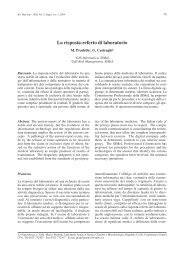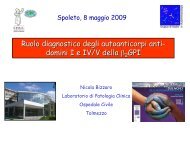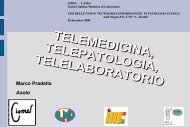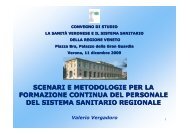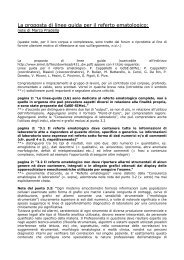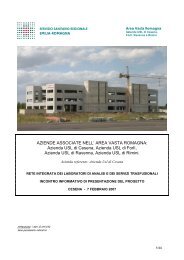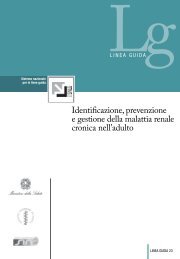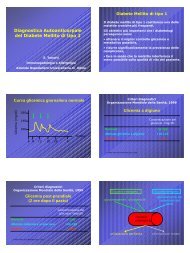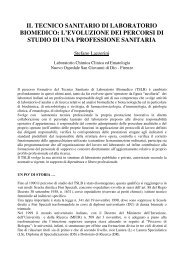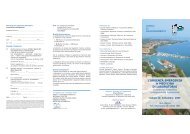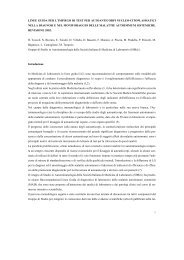Stato attuale delle tecnologie diagnostiche nelle malattie ... - Simel
Stato attuale delle tecnologie diagnostiche nelle malattie ... - Simel
Stato attuale delle tecnologie diagnostiche nelle malattie ... - Simel
You also want an ePaper? Increase the reach of your titles
YUMPU automatically turns print PDFs into web optimized ePapers that Google loves.
Renato Tozzoli<br />
Servizio di Medicina di Laboratorio<br />
Ospedale di Latisana (Ud)
IL CONSOLIDAMENTO<br />
DEI TEST<br />
AUTOANTICORPALI<br />
NEL LABORATORIO DI<br />
AUTOIMMUNOLOGIA:<br />
L’ESPERIENZA<br />
ESPERIENZA<br />
ITALIANA
The future of<br />
autoimmunology<br />
Fritzler MJ<br />
New technologies in the detection of autoantibodies<br />
From Proteomics to Molecular Epidemiology: Relevance of Autoantibodies<br />
Autoantibodies<br />
6th Dresden Symposium on Autoantibodies<br />
Dresden, September 4‐7, 4 7, 2002<br />
Multiplex testing<br />
1. Arrays of addressable laser microbeads<br />
2. Arrays on planar surfaces: microchip/membrane spotted arrays<br />
3. Microfluidics: ‘Lab Lab on a chip’ chip<br />
4. Nanotechnology and nanoengineering: nanobarcodes
L’evoluzione della<br />
tecnologia<br />
e le ricadute<br />
sui percorsi diagnostici
L’evoluzione <strong>delle</strong> <strong>tecnologie</strong> <strong>diagnostiche</strong><br />
<strong>nelle</strong> <strong>malattie</strong> autoimmuni<br />
I metodi convenzionali per il dosaggio autoanticorpale:<br />
le ‘vecchie <strong>tecnologie</strong>’<br />
L’impiego dei singoli test autoanticorpali nella diagnosi<br />
e nella prognosi <strong>delle</strong> <strong>malattie</strong> autoimmuni<br />
I metodi a determinazione multipla per il dosaggio<br />
autoanticorpale: le ‘nuove <strong>tecnologie</strong>’<br />
Il ruolo dei profili autoanticorpali nella predizione e nella<br />
prognosi di malattia
I metodi immunologici per la rilevazione<br />
autoanticorpale<br />
Tozzoli R, et al. Il Laboratorio <strong>nelle</strong> MRA. Esculapio, Bologna<br />
2007<br />
Bassetti D, et al. Il Laboratorio <strong>nelle</strong> MAO. Esculapio, Bologna<br />
2009<br />
Metodi immunologici convenzionali<br />
Metodi immunochimici (qualitativi)<br />
Metodi immunometrici (quantitativi)<br />
Metodi immunologici a determinazione<br />
multipla (multiplex o proteomici)
Classificazione dei metodi immunologici<br />
commerciali per la misura di autoanticorpi<br />
(2009)<br />
Convenzionali di I generazione<br />
Immunodiffusione doppia (ID)<br />
Fissazione del complemento (CF)<br />
Immunofluorescenza indiretta (IFI)<br />
Agglutinazione passiva (AP)<br />
Radiorecettoriale (RRA)<br />
Westernblot (WB)<br />
Convenzionali di II generazione<br />
Recettoriale (RRA, ERA, LRA)<br />
Radioimmunologico‐metrico (RIA‐IRMA)<br />
Immunoenzimatico‐metrico (EIA‐IEMA)<br />
Immunodot‐blot (IB‐DB)<br />
Immunochemiluminometrico (CLIA‐ILMA)<br />
Immunofluorimetrico (FIA‐IFMA)<br />
Convenzionali di III generazione<br />
Recettoriale (ERA)<br />
Proteomici (multiplex)<br />
Microarray<br />
a microsfere indirizzate (MBA)<br />
a microparticelle codificate (UCP)<br />
a microspot<br />
a nanodot (NALIA)<br />
Macroarray<br />
a blot lineare
I livelli di automazione dei metodi<br />
immunologici commerciali (2009)<br />
Manuali<br />
A tubi sensibilizzati<br />
A micropiastre<br />
Ad automazione parziale (a moduli)<br />
A micropiastre<br />
Ad automazione totale<br />
Dedicati ad analiti eterogenei<br />
Dedicati ad analiti omogenei (solo autoanticorpi)
Throughput<br />
L’evoluzione <strong>delle</strong> <strong>tecnologie</strong><br />
analitiche:<br />
il ruolo dell’automazione<br />
Metodi convenzionali<br />
manuali<br />
(IFI, DID, WB)<br />
1970<br />
Metodi convenzionali<br />
automatizzati<br />
(EIA, FIA, LIA, RIA)<br />
1995<br />
Metodi multiplex<br />
a bassa automazione<br />
(line blot, array)<br />
2003<br />
Metodi multiplex<br />
ad alta automazione<br />
(array)<br />
2006<br />
Time
L’evoluzione dell’attività<br />
del laboratorio clinico in<br />
autoimmunologia<br />
produttiva
I metodi a determinazione multipla<br />
(multiplexing): una nuova era<br />
per i test autoanticorpali<br />
High‐throughput protein‐array techniques are already available in which<br />
hundreds of autoantibodies specificities can be analyzed simultaneously.<br />
This technology might allow prospective studies of large numbers of healthy<br />
individuals for the development of many autoimmune diseases.<br />
Another alternative is to apply this technology to existing databases…..<br />
Testing these samples for multiple autoantibodies with protein arrays and<br />
correlating the results with diagnosed diseases might answer several<br />
important questions about the preclinical natural history of autoimmune<br />
diseases.<br />
Scofield RH. Autoantibodies as predictors of disease.<br />
Lancet 2004; 363: 1544‐6
Planar and Nonplanar Microarrays for<br />
Autoantibodies Tozzoli R. Clin Chem Lab Med 2008 (modified)<br />
Support Format<br />
Detection<br />
system<br />
AutoAbs<br />
tested<br />
Estimated<br />
throughput<br />
Microbeads Wells FL 9 1.000<br />
Microbeads<br />
Al‐barcoded<br />
microparticles<br />
Nitrocellulose<br />
membranes<br />
Nitrocellulose<br />
membranes<br />
Full<br />
automation<br />
Commercial<br />
product<br />
FIDIS,<br />
ATheNA,<br />
QuantaPlex<br />
Reference<br />
Rouquette,<br />
2003<br />
FL 15 2200 BioPlex 2200 Shovman,<br />
2005<br />
Wells FL 10 10.000 UltraPlex<br />
Microspots CL 30 1.000 Biochip<br />
Nanodots CL 10 1.000 NALIA<br />
Pang,<br />
2005<br />
Hentschel,<br />
2004<br />
McBride,<br />
2008<br />
Polystyrene chips Microspots FL 20 10.000 Impact Klause, 2007<br />
Glass slides Microspots FL 225 10.000 NA<br />
Glass‐slides<br />
gold‐coated<br />
Microspots SPR 24 10.000 NA<br />
Hueber,<br />
2005<br />
Segbers‐<br />
Lokate, 2007
Multiplexing: sistemi analitici<br />
e diffusione in Italia (2004‐<br />
2009)<br />
Azienda Sistema Profili/Antigeni Evoluzione Diffusione<br />
BMD, F (AU) FIDIS ANA/9, Rheuma/2, AIV/2<br />
Celiac/3, Thyroid/2<br />
IL (INOVA), S QuantaPlex ANA/8, AIV/2,<br />
Celiac/3, Liver/5<br />
ZEUS, USA Athena Multi-<br />
Lyte<br />
ANA/10, AIV/3<br />
Celiac/2, Thyroid/2<br />
? +<br />
? +/-<br />
++ +/-<br />
BIO-RAD, USA Bioplex 2200 ANA/13, ANCA/3 +++ +/-<br />
Pronostics, UK UltraPlex ANA/9, RF/3, aCL/3,<br />
Thyroid/2, Celiac/5, Liver/4<br />
+++ -<br />
ImmunoConcept Microzyme ANA/10 +++ -
Multiplex bead array (MBA):<br />
le soluzioni commerciali
Il Sistema AtheNA Multi‐<br />
Lyte<br />
AtheNA Luminex Lx‐200 Fully Automated Platform AIMS
Il sistema AtheNA e il suo<br />
sviluppo<br />
AtheNA Products Athena Future Products<br />
ANA II Plus (10 antigens)<br />
ANA III Plus (10 antigens)<br />
AIV Plus (3 antigens)<br />
Tg/TPO Plus (2 antigens)<br />
RF Plus (1 antigen)<br />
Celiac IgA Plus (2 antigens)<br />
Celiac IgG Plus (2 antigens)<br />
APS IgG (2 antigens)<br />
APS IgA (2 antigens)<br />
APS IgM (2 antigens)
Il sistema BioPlex 2200<br />
Lo strumento Le caratteristiche strutturali
BioPlex 2200: The Technology<br />
Components<br />
• Immunoassay format<br />
• Magnetic Beads<br />
• Automated Washing<br />
• Fluorescence Detection
The BioPlex 2200 Difference<br />
Patented Magnetic Beads<br />
Fully Automated<br />
Random Access<br />
Continuous Sample Loading<br />
STAT Capability<br />
100 Samples per hour<br />
1300 results on every ANA Screen Kit<br />
3 Internal QC Beads in Each Kit
The UltraPlex system<br />
The UltraCode Principles of the UltraPlex assays<br />
Al‐barcoded microparticles (UltraCode)<br />
Anti‐human IgG fluorescent coniugate<br />
The UltraPlex SmartReader detects<br />
fluorescence associated with each<br />
UltraCode<br />
96 deep well microplate<br />
ANA (10 autoantibodies)<br />
Thyroid (2 autoantibodies)<br />
Coeliac (5 analytes: AGA‐IgA, AGA‐pan‐<br />
Ig; tTG‐IgA; tTG‐pan‐IgG; Total IgA)
The UltraPlex system<br />
The UltraCode UltraPlex future products<br />
Liver (4 autoantibodies)<br />
aCL (3 autoantibodies: IgG,<br />
IgA, IgM)<br />
RF (3 autoantibodies: IgG,<br />
IgA, IgM)
The MicroZyme system<br />
The Microarray The BioChip
Ideal requirements<br />
of a proteomic technology<br />
for diagnostic and predictive purposes<br />
Bizzaro N, Tozzoli R, Shoenfeld Y. Arthritis Rheum 2007; 56:1736‐44<br />
Allow simultaneous determination of at least 25‐30 different autoantibodies<br />
Enable the detection of multiple antibody isotypes<br />
Be based on laboratory systems with high analytical accuracy<br />
Be highly automated with high troughput<br />
Have performance costs per antibody five/ten‐fold lower than those of<br />
conventional tests
Il ruolo del Laboratorio Clinico <strong>nelle</strong> <strong>malattie</strong><br />
autoimmuni:<br />
gli autoanticorpi come marcatori predittivi<br />
Marcatori predittivi di malattia in soggetti sani<br />
1. Nella popolazione ‘in toto’<br />
2. Nelle femmine in età puberale<br />
3. In gravidanza<br />
4. Nei familiari di soggetti affetti da <strong>malattie</strong> autoimmuni<br />
5. Nei soggetti sani con positività autoanticorpale casuale<br />
Marcatori predittivi di malattia in soggetti sintomatici<br />
1. Pazienti paucisintomatici<br />
2. Pazienti affetti da MRA<br />
3. Pazienti affetti da MAO<br />
Marcatori predittivi del decorso di malattia (prognostici)<br />
1. Attività<br />
4. Severità<br />
Leslie D, Lipsky P, Notkins AL. Autoantibodies as predictors of disease.<br />
J Clin Invest 2001; 108:1417‐22<br />
Bizzaro N, Tozzoli R, Schoenfeld Y. Are we at a stage to predict autoimmune rheumatic diseases?<br />
Arthritis Rheum 2007; 56:1736‐44
L’iceberg epidemiologico autoimmune<br />
Tozzoli R. RIMeL, 2008<br />
The sun:<br />
The environmetal agent<br />
The snorkel‐diver:<br />
The hystopathologist<br />
The aqualong diver:<br />
The autoimmunologist<br />
The man in the boat:<br />
The clinician
STATO DELL’ARTE<br />
E PROSPETTIVE<br />
DELLA DIAGNOSTICA<br />
DI LABORATORIO DELLE<br />
MALATTIE AUTOIMMUNI<br />
ORGANO‐SPECIFICHE
Evoluzione <strong>delle</strong> proposte dell’Industria<br />
Biomedica: sistemi ad automazione discreta<br />
Azienda 2003 2009<br />
1. ADALTIS Nexgen Bouty<br />
2. ALFA‐WASSERMANN Immunozone Medical Systems<br />
3. ASTRA ‐ AP‐Blot<br />
4. ALIFAX Tek‐6 Bellini<br />
5. BIOMEDIS‐BIOSYSTEMS ‐ AP22, APE<br />
6. BIO‐RAD Evolis PhD System<br />
7. DADE‐BEHRING BEP‐2000 Siemens<br />
8. DASIT ‐ AP22, APE<br />
9. DELTA BIOLOGICALS Mago Plus DW Mago Plus DW<br />
10. DIASORIN ETI‐Max ETI‐Max
Evoluzione <strong>delle</strong> proposte dell’Industria<br />
Biomedica: sistemi ad automazione discreta<br />
Azienda 2003 2009<br />
11. EUROIMMUN DSX I2‐P<br />
12. EUROSPITAL ‐ Impatto<br />
13. GRIFOLS Triturus Triturus<br />
14. IL ‐ QuantaLyser<br />
15. MENARINI Plato Zenit<br />
16. PHADIA DSX ‐<br />
17. RADIM Alisei Alisei, Brio 2<br />
18. TECHNOGENETICS DSX DSX
Sistemi ad automazione discreta<br />
(a moduli)
Sistemi ad automazione discreta<br />
(a moduli)
Evoluzione <strong>delle</strong> proposte dell’Industria<br />
Biomedica: sistemi ad automazione completa<br />
Azienda Napoli, 2003 Spoleto, 2009<br />
BAYER Centaur Siemens Centaur XP<br />
BECKMAN‐COULTER ‐ Access<br />
BIOALLERGY/BIO GENETIX ENEA System ENEA System, Ulisse<br />
DIASORIN Liaison Liaison<br />
MEDICAL SYSTEMS Immulite 2000 Siemens Immulite 2000<br />
IL‐INOVA ‐ Bioflash<br />
PHARMACIA/PHADIA ImmunoCap EliA 100 ImmunoCap EliA 100,250<br />
ROCHE Elecsys, Modular Elecsys, Modular<br />
RADIM ‐ RAD 120<br />
TECHNOGENETICS ‐ IDS‐iSYS
Il sistema di rilevazione negli<br />
analizzatori automatici<br />
Azienda Strumento Tracciante<br />
BECKMAN‐COULTER Access Chemiluminescenza<br />
BIO GENETIX Ulisse Chemiluminescenza<br />
DIASORIN Liaison Chemiluminescenza<br />
IL/INOVA BioFlash Chemiluminescenza<br />
PHARMACIA/PHADIA ImmunoCap EliA 100, 250 Fluorescenza<br />
ROCHE Elecsys, Modular Chemiluminescenza<br />
RADIM RAD 120 Fluorescenza<br />
SIEMENS Centaur XP, Immulite Chemiluminescenza<br />
TECHNOGENETICS IDS‐iSYS Chemiluminescenza
Sistemi ad automazione completa
Sistemi ad automazione completa di recente<br />
introduzione<br />
Phadia: ImmunoCap 250 Radim: RAD 120
Sistemi ad automazione completa di prossima<br />
introduzione<br />
IL: BioFlash Technogenetics: iSYS
La nuova estetica<br />
dell’automazione: Helmed Aesku e<br />
iPro BioSystems
SIMeL, GdS‐AIA, AIRA<br />
ringraziano<br />
ALIFAX GRIFOLS<br />
ASTRA IL‐INOVA<br />
BIORAD IMMUNOCONCEPTS<br />
BIOSYSTEMS‐BIOMEDIS LAGITRE<br />
DASIT MENARINI‐DIAGENE<br />
DELTA BIOLOGICALS PHADIA<br />
DIASORIN RADIM<br />
EUROIMMUN TECHNOGENETICS<br />
EUROSPITAL



